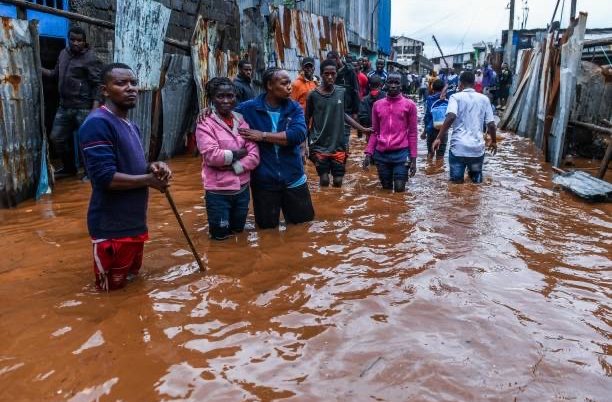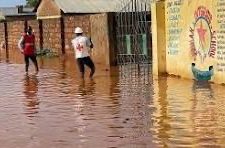Impact of Flooding on Health Care Services in Kenya: A Focus on Vaccination Challenges
The Boost Community highlights the stories of members committed to immunization work at the national and sub-national levels. The Boost Member Spotlight Series will regularly feature active Boost members who are engaged in relevant and innovative immunization activities in their contexts. If you have a story to share, please contact us at info@boostcommunity.org.
Introducing the Wote Youth Development Project
Peter Ngola Owiti leads the Wote Youth Development Project in Makueni County, an organization founded in 1999, that focuses on advocacy for public health tools and services, aiming to empower communities through education and engagement. Representing local communities on various platforms—including the Global Fund Tuberculosis constituency and the WHO-led Access to Covid Tools Accelerator—Owiti values the importance of translating scientific information into actionable knowledge for community members. The organization relies on volunteer community health workers to provide critical services such as triaging patients, offering health education, and conducting contact tracing.
Impact of Flooding on Vaccination Efforts
The recent flooding in Makueni County has severely impacted health care facilities, disrupting services and straining resources. Key areas affected in Makueni County include Mbulutini, Mutyambua, Nunguni, Kawese, Kithungo, Kitundu, Kikima.
The floods disrupted health care services in several ways:
- Movement restrictions: Impassable roads and damaged infrastructure made it difficult or impossible for patients to reach health care facilities.
- Facility closures: Some health care centers were forced to close due to flooding, cutting off access to necessary medications.
- Treatment interruptions: These accessibility issues led to interruptions in treatment regimens, potentially compromising patient outcomes.
- Forced relocations: Some patients had to relocate due to flooding, further complicating their ability to maintain consistent treatment.
- Disease progression and transmission: TB patients experiencing symptoms often remained indoors due to the floods, potentially infecting household members and later presenting with more advanced stages of the disease.
Moreover, the floods had a profound impact on vaccination efforts, exacerbating an already tenuous situation. Before the floods, Kenya faced vaccine stockouts due to a debt to Gavi and UNICEF, which hampered access to essential vaccinations. As a result of the flooding, approximately 1.5 million children missed mandatory vaccines. The logistical challenges of transporting vaccines from distant facilities became increasingly difficult during this period, particularly for “day zero” facilities, which do not maintain cold storage.
Despite the lack of human resources, community health workers played a vital role in tracing children who missed vaccinations, yet challenges such as misplaced records and vaccine hesitance hindered these efforts. The community’s response to newly introduced vaccines, such as those for malaria and HPV, was further complicated by misinformation and pushback from the Christian community.
Challenges on Resources
As noted in the challenges listed above, the floods resulted in significant disruptions to transportation networks, with many roads rendered impassable due to mudslides and washed-away bridges. This hindered access to medications and essential supplies. Healthcare workers faced challenges in reaching facilities, which compounded the issues of absenteeism and disrupted supply chains.
The floods not only delayed drug collection but also hindered vaccination efforts. With many healthcare facilities either flooded or damaged, patients were relocated, incurring additional out-of-pocket expenses. The rise in waterborne diseases—such as cholera and typhoid fever— and the uptick in malaria cases further strained the already overburdened healthcare system. Tragically, 27 lives were lost during the flooding.
For Peter, Kenya Red Cross volunteers are often the first responders in humanitarian emergencies, facing stressful and traumatic situations that can significantly affect their emotional and psychological well-being. For instance, in Sultan Hamud, a tragic incident occurred when a lorry was swept away by floodwaters, leading to a mass casualty event where 14 people were rescued, but one lost their life and two remain missing. KRCS volunteers, alongside the Makueni County Directorate of Emergency Services, worked tirelessly in the aftermath. The emotional toll on responders was substantial as they witnessed grief-stricken families and traumatized survivors. This incident deeply affected the local community, leaving families in mourning and the community grappling with shock and sorrow. In response, volunteers and staff have been providing psychological first aid and conducting debriefing sessions to support the mental health of both the community and the affected responders.
Adaptations to Ongoing Challenges and Strategies for Resilience
In response to these challenges, healthcare facilities have taken steps to ensure continued care, such as: repairing damaged buildings and constructing barriers to prevent water entry; redirecting patients to safer facilities and providing makeshift camps for displaced individuals; conducting follow-ups for children who missed vaccinations during the floods; and utilizing local media to educate the community on waterborne diseases.
In Peter’s view, local authorities and international organizations must collaborate to enhance disaster response capabilities and invest in resilient healthcare infrastructure. Specifically, they should consider several long-term strategies to build resilience against climate-induced disasters:
- Capacity Building: Empowering communities with knowledge about flood risks and prevention.
- Infrastructure Development: Implementing stringent building laws and improving drainage systems.
- Emergency Preparedness: Establishing emergency funds and medical stockpiles to ensure a rapid response during crises.
- Financial Assistance: Grants and loans for resilient healthcare infrastructure and support for emergency relief efforts/Increased funding for disaster preparedness and financial incentives for healthcare facilities to improve flood resilience.
- Coordination and Collaboration: Facilitating partnerships among stakeholders and coordinating international relief efforts.
- Research and Development: Supporting studies on flood impacts on healthcare systems and promoting innovative flood prevention technologies.
Conclusion
The recent flooding in Kenya has highlighted the vulnerability of healthcare systems to climate-related disasters. While immediate challenges have been significant, particularly in vaccination efforts, the experience has also prompted a reevaluation of long-term strategies to build resilience in the healthcare sector. Continued support from local authorities and international organizations will be crucial in addressing these challenges and ensuring the health and well-being of affected communities. As advocates for health and well-being, healthcare professionals like Peter play a crucial role in driving these efforts forward, ensuring that communities remain informed and resilient in the face of adversity.

Peter Ngola Owiti
Peter Ngola Owiti is the executive director and founder of a community-based organization in Kenya formed in the year 2000 to advocate for prevention of HIV and TB, diseases that claimed 13 members of his family. He has over 20 years of experience working with communities on Tuberculosis and HIV & AIDS at the youth friendly facility in Wote town. He is a global advocate for access to quality healthcare services as human rights interventions and holds a Master’s degree in Agriculture and Policy Development and is currently working to obtain a doctorate degree in Public Health (Community Health).



